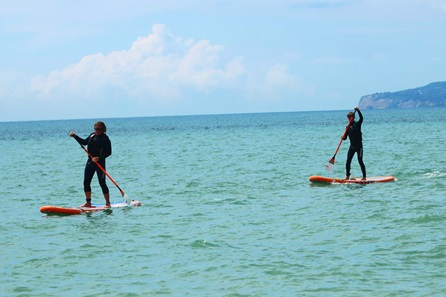Introduction
Paddle boarding is an exhilarating water sport that offers a unique way to explore the ocean, rivers, and lakes. However, paddling in busy beach areas comes with its own set of challenges and risks. This article provides essential safety tips to ensure that you enjoy your time on the water while minimizing the risk of accidents or injuries. Whether you’re a seasoned paddleboarder or a beginner, these tips will help you navigate crowded waters safely.
Choose the Right Location
When paddle board in busy areas, it’s crucial to choose a spot that’s appropriate for your skill level. Beginners should stick to calmer waters, such as bays or lagoons, where there’s less boat traffic and fewer waves. Advanced paddlers might enjoy the challenge of more dynamic waters, but they should always be mindful of their surroundings and the presence of other watercraft.
Check the Weather and Water Conditions
Before heading out, always check the weather forecast and water conditions. Strong winds, high tides, and rough seas can make paddle boarding dangerous, especially in crowded areas. Avoid going out if the weather looks unpredictable. Also, be aware of rip currents and strong tides, as they can quickly pull you away from shore.
Wear a Personal Flotation Device (PFD)
A personal flotation device (PFD) is an essential piece of safety equipment. Even if you’re a strong swimmer, a PFD can be a lifesaver in an emergency. It’s particularly important in busy beach areas, where collisions with boats or other paddle boarders are more likely. Make sure your PFD fits properly and is approved by relevant safety standards.
Use a Leash
A leash is a critical safety accessory that keeps you connected to your board. In the event of a fall, the leash prevents your board from drifting away, which can be especially dangerous in crowded waters. There are different types of leashes for various conditions, so choose one that’s suitable for the environment you’ll be paddling in.
Stay Visible
Visibility is key to staying safe on the water. Wear bright, high-visibility clothing, and consider attaching a brightly colored flag to your board. This helps other water users, including boaters and jet skiers, see you from a distance. In low-light conditions, such as early morning or late afternoon, it’s advisable to use a light or reflective gear.
Be Aware of Your Surroundings
One of the most important aspects of paddle boarding in busy areas is situational awareness. Always be mindful of other water users, including swimmers, surfers, and boaters. Keep a safe distance from other watercraft, and be cautious when navigating around anchored boats or crowded areas. If you’re in a designated swimming area, make sure to stay outside the marked boundaries.
Communicate with Others
Communication is crucial when paddle boarding in busy areas. If you’re with a group, establish a set of hand signals or verbal cues to communicate. This can help you alert others to potential hazards or coordinate movements. If you encounter other water users, a friendly wave or shout can go a long way in avoiding collisions and misunderstandings.
Know the Local Regulations
Different beaches and waterways have specific regulations that govern water activities. These rules may include designated areas for paddle boarding, speed limits, and restrictions on certain types of watercraft. Familiarize yourself with the local regulations before heading out, and always adhere to them. Ignoring these rules can not only put you at risk but also result in fines or other penalties.
Practice Proper Etiquette
Good etiquette is essential for a safe and enjoyable paddle boarding experience, especially in busy areas. Yield to larger vessels, give way to swimmers, and avoid paddling too close to other boarders. If you’re surfing, follow the established right-of-way rules to prevent collisions. Respecting others on the water helps create a safer and more enjoyable environment for everyone.
Have a Plan and Let Someone Know
Before setting out, always have a plan. Know where you’re going, how long you plan to be out, and what route you’ll take. It’s also a good idea to let someone on shore know your plans, especially if you’re paddling alone. This way, if something goes wrong, someone will know where to look for you.
Conclusion
Paddleboarding in busy beach areas can be a thrilling experience, but it’s essential to prioritize safety. By choosing the right location, checking weather conditions, wearing appropriate safety gear, and being aware of your surroundings, you can minimize risks and enjoy your time on the water. Always remember that the key to a safe paddle-boarding experience is preparation and awareness. Whether you’re searching for paddle boards for sale or simply looking to enjoy a day on the water, following these safety tips will ensure a safe and enjoyable adventure.
Keep an eye for more news & updates on Tribune Indian!




